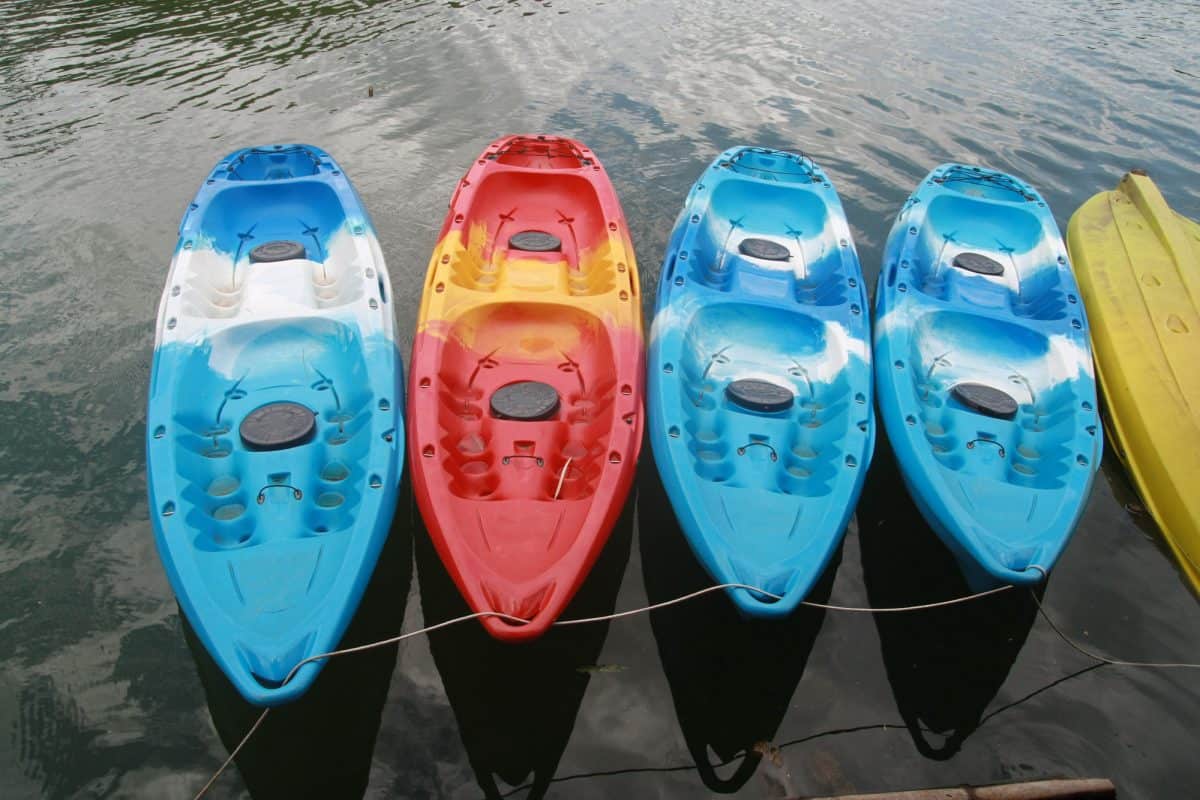Your sit-on-top kayak can be equipped with many accessories, some of which are considered luxuries, while others fall into the “kayaking essentials” category.
What about kayak scupper plugs, though?
When it comes to plugging the little holes in the bottom of your kayak, the line between “necessary” and “optional” tends to be blurred – or flat-out confusing:
If you don’t use scupper plugs, water comes in – and if you do, water builds up, anyway.
Should you even bother with kayak plugs, and if so, what’s the point?
Let’s go over the ins and outs of scupper plugs together!
What Are Scupper Plugs & How Do They Work?

Before you can answer those questions you first need to answer; what is a scupper hole? And, how do scupper holes work?
Like me, did you also have that “Wait, why does my kayak have holes at the bottom” moment when you first encountered a sit-on-top kayak?
I mean, most boats have scupper holes that act as drains, getting rid of excess water; they likely have the same purpose in a sit-on-top kayak, too.
But I couldn’t, for the life of me, figure out why they’re located on the hull’s bottom – at water level!
These holes let in minimal amounts of water under normal conditions due to the vessel’s inherent buoyancy. So, no, they won’t sink your kayak.
In fact, they prevent it from pooling at the bottom, by allowing the water to drain, improving the kayak’s efficiency and safety through something called self-bailing – a feature exclusive to sit-on-top kayaks.
Some paddlers do choose to close these holes with a sort of bathtub-plug-like accessory known as a scupper plug.
Why?
Sometimes you want to bypass that self-bailing feature of your sit-on-top kayak – especially if you’re loaded with gear or paddling in rough conditions, and you’re taking in more water through the holes than usual – aka too much water!
Glorified bathtub plugs to the rescue!
Okay, calling them “glorified bathtub plugs” might sound a little harsh.
Then again, we’re talking about small, rubber (or plastic) thingies that cover the drains in your kayak’s hull; the bathtub plug comparison isn’t too far off if you ask me.
And that’s the response I am sticking with when people ask, what is a scupper plug?
Are Scupper Plugs A Must-Have For A SOT Kayak?

So, do I need scupper plugs?
Yes – and also no. It depends.
I know that wasn’t an incredibly helpful answer, but here’s the thing:
If you decide to plug your kayak’s scupper holes, water won’t be able to enter the kayak from below, which should amount to a drier trip. On the flip side, any water that finds its way into the cockpit won’t be able to drain out now that the holes are plugged.
It’s a decision you should make on a case-by-case basis – and more often than not, it’s going to mean compromising between comfort and safety.
Any Downsides To Using Scupper Plugs?
Considering the primary purpose and the sole design reason of having scupper holes on sit-on-top kayaks – self-bailing – installing kayak plugs does come with one significant downside:
Your kayak will lose its inherent ability to remove the excess water from the cockpit through the self-draining holes in the hull.
Too much water entering the cockpit and pooling on the kayak’s deck can be quite uncomfortable and, even worse, affect your yak’s performance and buoyancy.
Trust me, sitting in a puddle of water for any length of time isn’t much fun.
Does that mean that you shouldn’t use scupper plugs?
Not at all – but you’ll have to figure out an alternative solution for getting rid of all the water yourself.
Getting Rid of Excess Water (With & Without Kayak Scupper Plugs)
Paddle splashes, rain, waves, and choppy waters; allow water to enter the cockpit and collect on the deck, which all adds up – and you have to be able to remove the water manually.
If you’re only dealing with small puddles that are more annoying than a safety issue, a simple kayak sponge will do. Keep one on board whenever you’re paddling in mild conditions and flat water, where there’s little chance of the hull filling up with water.
Then again, if you capsize, a sponge won’t do much to drain the excess water. You’ll have to pull out your big guns – your bilge pump.
It’s already a must-have for sit-inside kayaks. If you decided to keep your sit-on-top kayak’s scupper holes plugged – which, again, can affect its self-draining abilities – add a bilge pump to your standard kayaking gear, too.
Oh, and don’t forget that removing the scupper plugs to allow water to drain and then putting them back in is also an option.
How To Use Scupper Plugs: Essential Tips & Know-How For Kayakers

If you ever used a bathtub plug before, you won’t have an issue figuring out how scupper plugs work, either.
It’s not that hard; that’s all I’m saying.
So, this isn’t so much about step-by-step tutorials on how to insert scupper plugs into the kayak’s holes. Push it down into the scupper hole and make sure it’s firmly in place; I’d say that part is pretty self-explanatory.
Instead, I’d like to go over some ground rules on how to use scupper plugs properly.
How To Test The Fit Of Kayak Plugs
Most universal, one-size-fits-all scupper plugs will have a round, slightly tapered design that should be compatible with most sit-on-top kayaks. However, the issue with a universal kayak scupper plug is that kayak manufacturers use different-sized scupper holes:
So, are scupper plugs universal? While the plug’s tapered design theoretically fits into the scupper hole, the actual seal could be less than ideal – or flat-out non-existent. The smaller contact area between the two can often result in a weaker seal.
So, opt for plugs that are the exact match for your specific yak whenever possible – and test the fit before you head out on the water. Anything less than a water-tight fit is a no-go.
On that note, here’s how to test the fit of scupper plugs from the comfort of your backyard:
Insert the scupper plugs, fill your kayak with water so the deck is an inch deep, and then observe the outside of the hull – especially underneath and around scupper holes – for signs of leaking water.
If there’s any dripping with the kayak plugs in place, you either didn’t install them correctly, or they aren’t a good fit; it’s as simple as that.
Use Scupper Plugs Underneath Your Seat For Self-Bailing Effect
Scupper holes are there for a reason – and you can’t close them up without it affecting your sit-on-top kayak’s self-draining properties.
But mix things up a bit, and you can have your cake and eat it, too:
Leave the scupper holes near the bow and stern open and close the ones closest to you, such as those located directly underneath the kayak seat. That way, you get to keep some of the self-bailing characteristics of kayaks with scupper holes, while also keeping the deck relatively dry.
Make Sure They’re Easy To Remove (While You’re Still On The Water)
As I said, the whole insert-plugs-into-drain-holes thing is pretty self-explanatory. Removing the plugs when they’re no longer needed can be a bit tricky, though, especially while you’re still on the water:
You’re reaching for the bow and stern scupper plugs, struggling to get a good grip and pull them out, all while trying to maintain balance and prevent the yak from capsizing.
That doesn’t sound very convenient, huh?
One way to ensure that they’ll be easy to remove when needed – both on land and on the water – is to use kayak plugs that come with pull-out cords attached. If not, you can always add the threads yourself for easier removal.
Also, make sure that the actual kayak plug isn’t too big for the drain hole. You might be able to force them in, but no amount of pull-out strings will help you get them out if they get stuck due to sizing issues.
Don’t Leave The Scupper Plugs In When Storing Your Kayak
When you’re ready to store your kayak, be sure to remove the scupper plugs first.
Here’s the thing:
Rotomolded plastic tends to be sensitive to temperature changes, causing the kayak’s hull to expand and contract.
So, if you happen to store your kayak with the scupper plugs still installed, these temperature changes could cause them to get stuck in the drain holes permanently. Worst-case scenario, this could lead to severe hull damage, such as dents and cracks.
Also most scuppers are made of rubber, which parishes when exposed to salt water and the elements – it’s a good idea to periodically replace your kayak plugs.
Especially if you don’t fancy sitting water for the duration of your paddle – no one wants a wet backside
Fitting the kayak cart’s metal poles inside scupper holes seems like a convenient solution for keeping the kayak steady during transportation. However, the areas around the seams – along the edges of the hull and inside scupper holes – are your vessel’s weakest points.
You could end up with a crack in the hull – and a leaky kayak!
DIY Scupper Plugs: Quick-And-Easy Project For The Crafty

You can get aftermarket scupper plugs from your local outdoor equipment store or virtually any online retailer – and they’re usually cheap, too. But if you’re up for DIY-ing, making your kayak scupper plugs is also an option.
As long as they serve the primary purpose – closing the scupper holes – it doesn’t matter if they’re store-bought or home-made.
One of the most popular DIY scupper plugs ideas involves making them out of foam practice golf balls.
Here’s what you’ll need:
- Foam golf balls
- Paracord
- Plastic or metal washers
- Screwdriver or a large nail for making holes in the golf balls
- Scissors
- Lighter (or any other heat source) to prevent the paracord from unraveling
- Piece of wire or a large needle for pulling the paracord through the golf balls
- Pliers
Watch this video for a quick-and-easy example of how to make your own cost-effective DIY scupper plug:
Final Word On Kayak Scupper Plugs
The whole “to use or not to use scupper plugs” or “do I need or not need scupper plugs“ debate doesn’t have a definite outcome – it all depends on the circumstances. You’ll have to make this call each time you launch your sit-on-top kayak.
I mean, you can’t get into on-the-water sports and expect to stay completely dry at all times. A few splashes here and there come with the territory; it’s the nature of the sport. Then again, sitting in a puddle of water for hours on end is no one’s idea of fun.
If anything, I recommend you have the kayak scupper plugs on hand just in case:
Keep the scupper holes open in “normal” conditions – and close them up if you feel like you’re taking on too much water.
